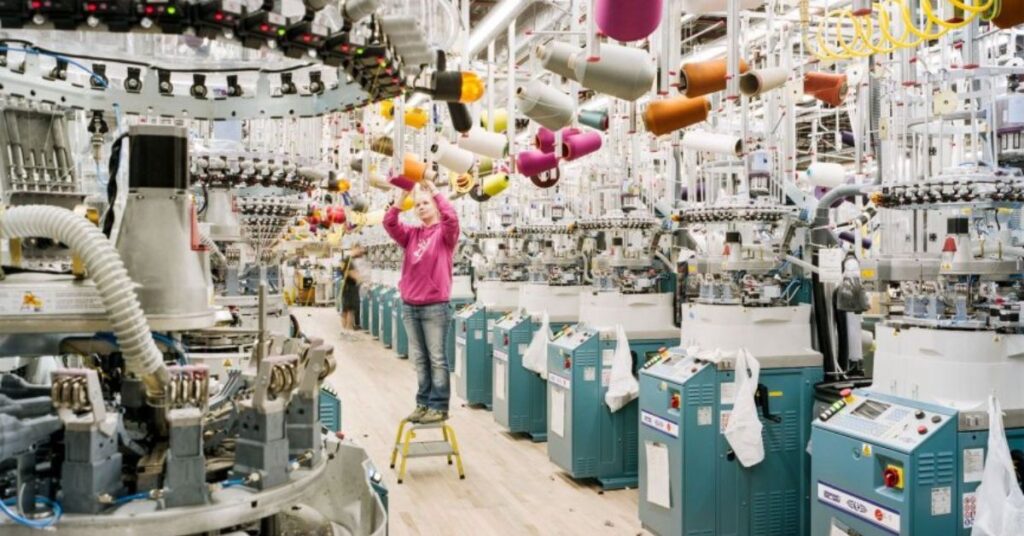The textile industry is undergoing a transformation. With growing awareness of its environmental impact and CO2 emissions, businesses are adopting sustainable textiles to meet consumer demand. In the USA, fast fashion impact is a concern, with increased calls for ethical production and fair labor practices. Innovations like mycelium-based leather and bio-based materials are shaping the future. These advancements aim to address challenges such as the global carbon footprint while promoting regenerative agriculture and biodegradable materials.
The textile industry is evolving rapidly, driven by innovations aimed at creating sustainable materials and production processes. From eco-friendly fabrics to cutting-edge manufacturing technologies, the goal is to minimize environmental impact while enhancing quality and efficiency. As the world shifts towards sustainability, the future of textiles focuses on creating products that are not only stylish but also environmentally friendly.
As environmental concerns grow, the textile industry is embracing new technologies to meet sustainability goals. From biodegradable fabrics to smart textiles that reduce waste, these innovations are transforming how we think about clothing and fabric production. In a world increasingly focused on reducing carbon footprints, the future of textiles promises not only economic benefits but also significant environmental improvements.
Groundbreaking Fabrics Redefining Sustainability
New eco-friendly fabrics are revolutionizing the industry. Materials such as mycelium, which is used in Mylo™, are gaining attention for their versatility and sustainability. Mycelium grows quickly, requires minimal resources, and decomposes naturally. It is now being used as an alternative to leather, providing a cruelty-free and climate-conscious clothing option. Similarly, sustainable fashion brands are embracing organic cotton farming to reduce water usage and pesticide reliance, further minimizing textile industry CO2 emissions.
Advances in microbial dyes are also making a difference. Companies like Colorifix and Faber Futures use bacterial pigments to create vibrant colors with less environmental impact. Unlike traditional textile dyeing processes, which use harmful chemicals, these methods are safer and more sustainable. The integration of biodegradable fabrics and sugar cane rubber is paving the way for truly ethical textile production.
You May Read This My Blog: The Art of a Peaceful Life: Find Serenity in a Busy World
| Sustainable Materials | Key Benefits |
| Mycelium | Biodegradable, low resource use |
| Organic cotton | Reduced water, no pesticides |
| Sugar cane rubber | Renewable, durable |
Current Trends and Challenges in the Textile Industry

Sustainable textiles are trending as consumers demand climate-conscious clothing. Platforms like the Fashion Revolution campaign and #WhatsInMyClothes campaign emphasize transparency. Gen Z purchasing power is driving change, as younger consumers prefer brands prioritizing sustainability and worker’s rights.
However, the industry faces challenges. The high cost of biodegradable materials and innovative technologies like Fine Mycelium™ hinders widespread adoption. Additionally, textile farming methods must shift to regenerative agriculture practices to address the environmental toll of traditional methods. Tackling these challenges will require collaboration among governments, businesses, and consumers.
Opportunities in the Textile Industry
The future offers exciting opportunities for innovation. Technologies like Streptomyces coelicolor, which produces natural dyes, and ethanol-based rubber, which is derived from renewable sources, hold immense potential. Adopting these technologies will not only reduce the global carbon footprint but also enhance product quality.
Government incentives in the USA are encouraging sustainable textile dyeing and manufacturing processes. Companies are investing in carbon footprint reduction measures, such as adopting biodegradable fabrics and improving supply chain efficiency. Furthermore, luxury fashion sustainability is becoming a priority, with brands incorporating bio-based materials and supporting fair labor practices to attract eco-conscious consumers.
Textile Revolution: Innovations Changing the Game

Innovations are redefining the way textiles are made. Mylo™, a product of mycelium, offers a cruelty-free alternative to traditional leather. It is durable, stylish, and aligns with the principles of sustainable fashion. Similarly, sugar cane rubber is replacing synthetic rubber, providing a renewable option for footwear and accessories.
Another breakthrough is the use of bacterial pigments in dyeing. These pigments, derived from organisms like Streptomyces coelicolor, significantly reduce water pollution and energy consumption. Textile dyeing processes are evolving to embrace such eco-friendly innovations, ensuring a more sustainable future for the industry. Companies like Adidas and Stella McCartney are leading the way, integrating these materials into their designs.
FAQ’s
What are the key innovations in the textile industry for sustainability?
Innovations such as biodegradable fabrics, recycled fibers, water-saving production methods, and smart textiles that minimize waste are leading the charge toward a sustainable future in textiles.
How are textiles contributing to environmental problems?
Traditional textile production consumes large amounts of water, energy, and chemicals, contributing to pollution and waste. The industry’s fast-fashion model further exacerbates environmental damage.
What role do biodegradable fabrics play in sustainable textiles?
Biodegradable fabrics, made from materials like organic cotton or hemp, decompose naturally without leaving harmful residues, reducing waste in landfills and promoting a more eco-friendly lifecycle for textiles.
How are smart textiles changing the textile industry?
Smart textiles incorporate advanced technologies such as sensors or responsive fibers that can adapt to their environment. These innovations help reduce waste, improve performance, and contribute to sustainability.
What can consumers do to support sustainable textiles?
Consumers can choose eco-friendly fabrics, support brands focused on sustainability, reduce textile waste by recycling or upcycling, and be mindful of purchasing habits to reduce demand for fast fashion.
Conclusion
The transformation of the textile industry is essential for a sustainable world. By adopting biodegradable fabrics, reducing CO2 emissions, and embracing innovations like Fine Mycelium™, the industry is addressing its environmental challenges. Sustainable textiles and ethical practices will shape the future, with initiatives like the Fashion Revolution campaign inspiring change.To achieve lasting impact, collaboration is key. Consumers can support the movement by choosing climate-conscious clothing and advocating for transparency. Together, the industry and its stakeholders can create a greener, fairer world for future generations.







